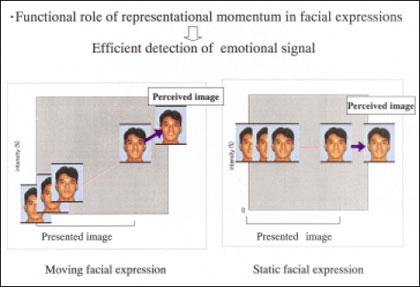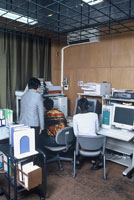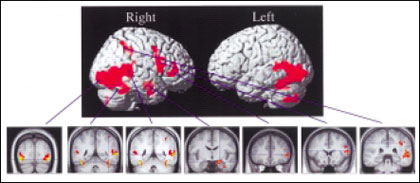Facial Expression and Gaze are the Windows to the Soul? :
Psychology of Social Perception.
My research field is cognitive psychology and I am interested in various aspects of the way faces are perceived, especially the ways people recognize social signals contained in a face. My current research focuses on perception of dynamic facial expressions, the effect of eye gaze on directing attention, and the relationship between emotional facial expression and gaze direction processing. All of these are concerned with elucidation of human social competence, which enables us to perceive the emotions and intentions of others, to understand relations between ourselves and others, and to modulate our behavior flexibly in face-to-facecommunication. For my research, I am adopting both an experimental and neuroscientific approaches that include techniques such as brainimaging (Figure 1). As the neuroscience of social cognition has made great progress during the past few years, it is really exciting to devise hypotheses for psychological experiments and the interpretation of experimental evidence in relation to recent neuroscientific findings. Below, I describe some of the results of recent research carried out in my laboratory.
1.Perception of dynamic facial expressions
Though it may seem rather strange, there has been surprisingly little psychological research until recently on how dynamic facial expressions are perceived. I suspect this situation has partly stemmed from the methodological difficulty in controlling and manipulating video clips of natural expressions as experimental stimuli. Instead of using video clips of natural facial expressions, we created computer animation clips in which we rapidly present intermediate frames to seamlessly transform a face with a neutral expression into one of six emotional expressions: happiness, anger, sadness, fear, surprise and disgust. This method makes it possible to avoid uncontrollable factors like head movement and eye blinking, also enables us to manipulate systematically parameters such as the rate of change of moving facial expressions.
Using these computer-animated dynamic stimuli, we have carried out psychological and neuroscientific experiments focusing on different stages of facial expression processing (perception, recognition of emotion, facial reaction of the perceiver, and so on). For example, we investigated how people perceive dynamic facial expressions and how their velocity affects their perception, focusing on the "representational momentum" phenomenon( Figure 2). "Representational momentum" denotes the phenomenon whereby the final shape or position of an transforming object is shifted ("distorted"), in the perceiver's mind, in the direction of an observed transformation. In the experiment, after watching an animated clip of emotional expression, participants reproduced on the display the image they thought matched the last image shown in the clip. Quantitative analysis of the image produced by the participants revealed that when perceiving dynamic facial expressions, the last image participants perceived was an intensified image of facial expression and the degree of distortion depend on the velocity of the stimuli. This is the first demonstration of representational momentum in the perception of dynamic facial expression, and it implies that the human perceptual system works quite efficiently in detecting an emotional signal from another individual, which may help to predict that person's subsequent behavior.

Figure 2
2.Interaction between emotional expression and gaze direction
Not only facial expression but also face/gaze direction provides an important clue to another person's mental state. Recent neuroscience literature offers an accumulation of convincing evidence indicating that the same face-responsive brain areas in the occipito-temporal region (superior temporal sulcus) and in the amygdala are involved in processing both facial expression and gaze direction. This strongly implies an intimate interconnection between the two. Thus, we hypothesized that facial expression and gaze direction processing interact in the early stages of visual perception. Focusing on "the threatening face advantage" in the perception of facial expression, we investigated whether gaze direction modulates this effect by using a perceptual matching task. The threatening face advantage is a phenomenon in which angry, threatening faces are more quickly and accurately detected than are other emotional faces. As predicted, face/gaze direction affected the early visual stages of facial expression processing; a threatening face looking toward the perceiver was processed more accurately than the same face looking away. These results imply that humans have an ecologically valid mechanism for detecting a threatening signal and efficiently avoiding imminent potential danger.
In the field of social cognition, many interesting research questions remain untouched. I hope our approach can shed light on psychological functions and their neural underpinnings that make it possible for us to understand each others' minds, and enjoy a wide variety of social interaction and communication.

An experiment in progress. When advising students, Prof. Yoshikawa constantly urges having a strategy for one's research and taking a positive approach toward joint research.

The testing laboratory. Prof. Yoshikawa's research is built on an accumulation of detailed data from experiments.

Sakiko Yoshikawa
Born in 1954.
Graduate of the doctoral program, Graduate School of Education, Kyoto University
Ph.D., Kyoto University
Professor, Graduate School of Education, Kyoto University
URL DIVISION OF COGNITIVE PSYCHOLOGY IN EDUCATION (External Link)
"Right now my thinking is that by accumulating small pieces of basic research it may eventually be possible to complete the jigsaw puzzle."
Prof. Yoshikawa got the idea for her research while studying in Britain in 1989, and since then she has pursued it unwaveringly. Now she really enjoys doing her research. In recent years her research and experiments have undergone substantial change. Advances in neuroscience and primatology have made the brain itself the subject of study, and collaboration with experts in other fields has become indispensable. For her being at Kyoto University among researchers in a wide range of fields is a tremendous advantage. For example, Prof. Yoshikawa is participating in the 21st Century COE Program. With the goal set at "knowing mind and fostering mind ", the project aims to comprehensive understanding of mental functions by integrating experimental, field, and clinical approaches to mind. This joint research project involves scholars from the Graduate School of Letters, Graduate School of Human and Environmental Studies, and Graduate School of Informatics. Picking up small pieces from many different fields, each day she comes closer to the completion of the puzzle.


